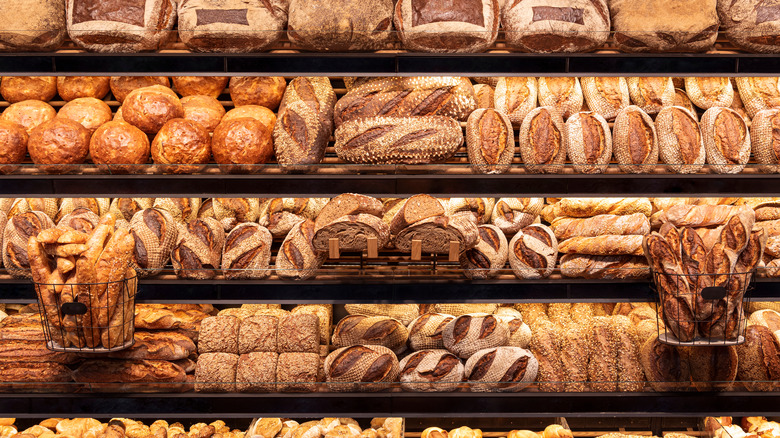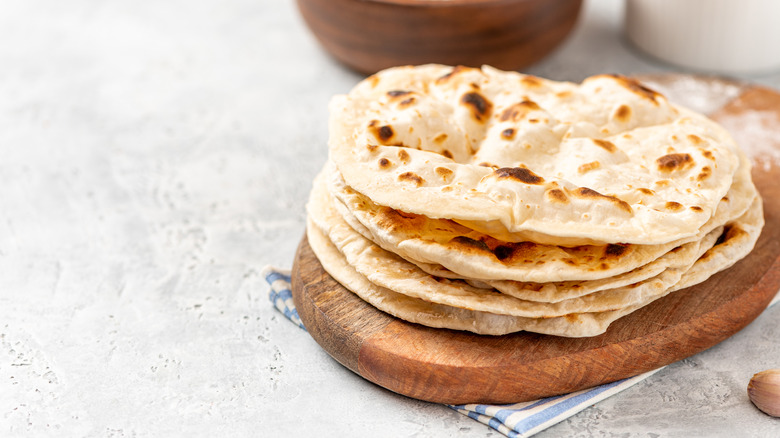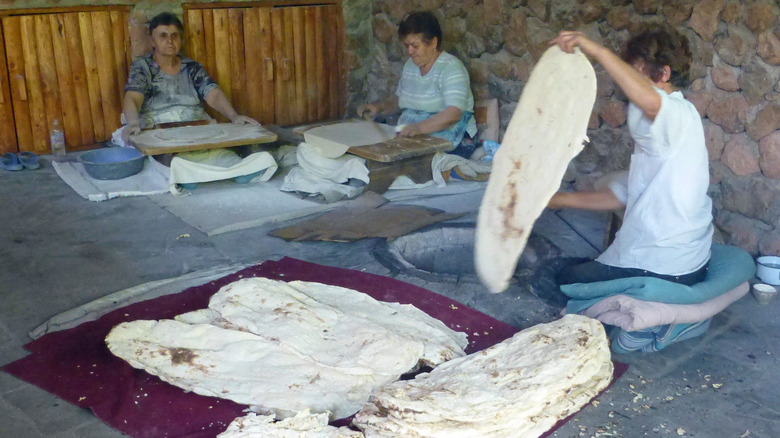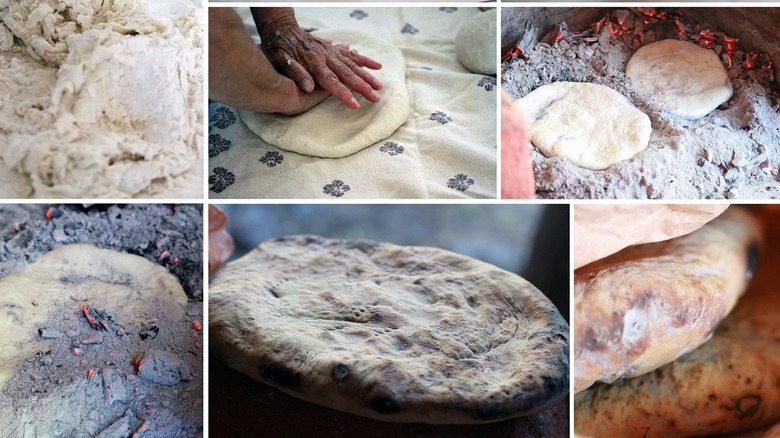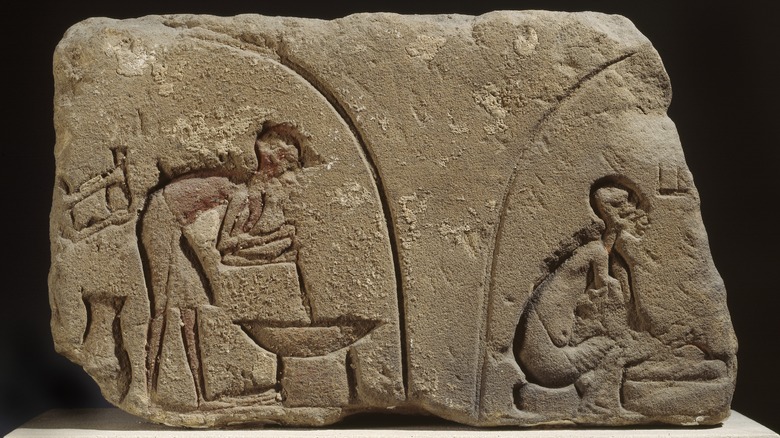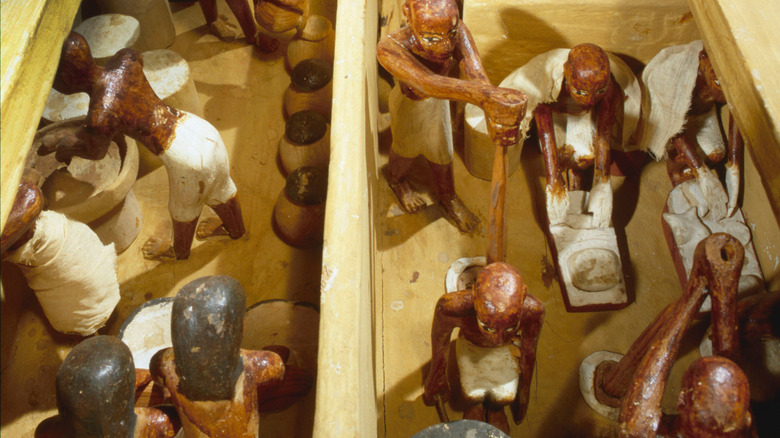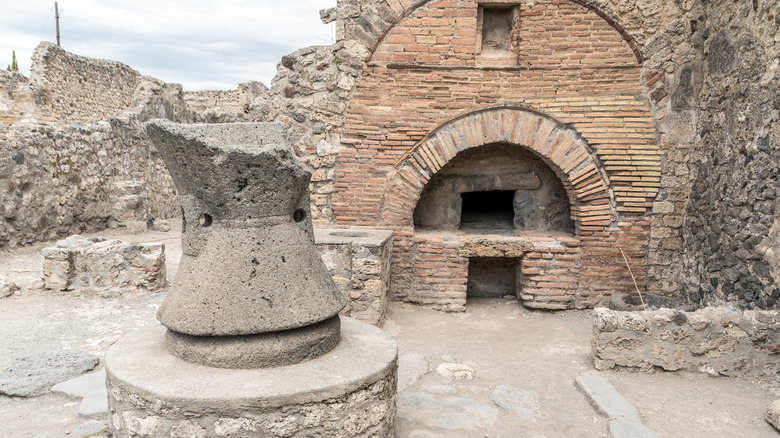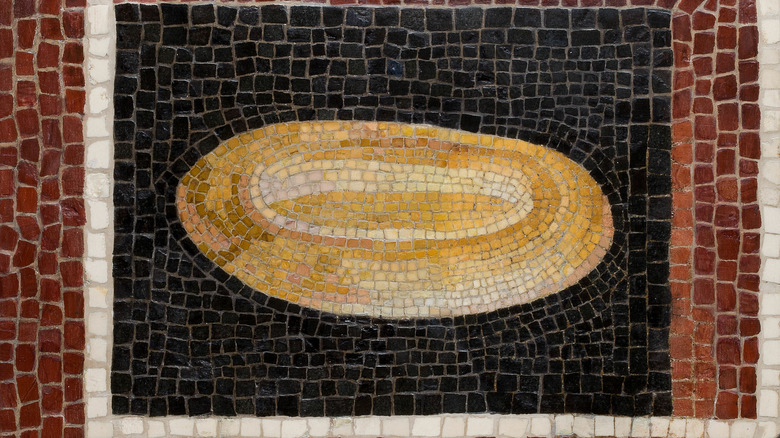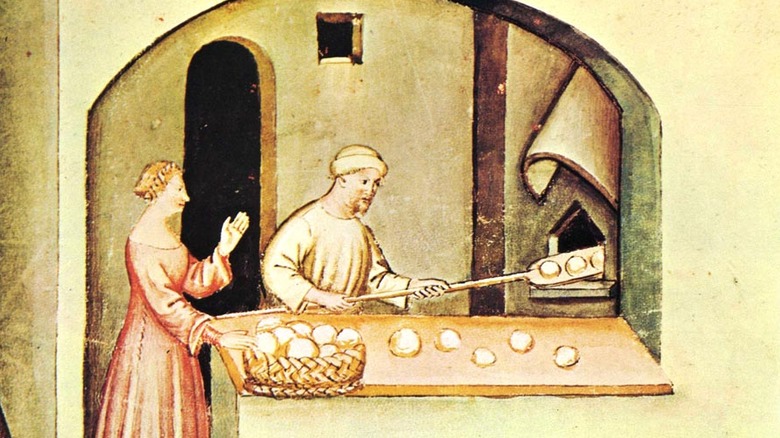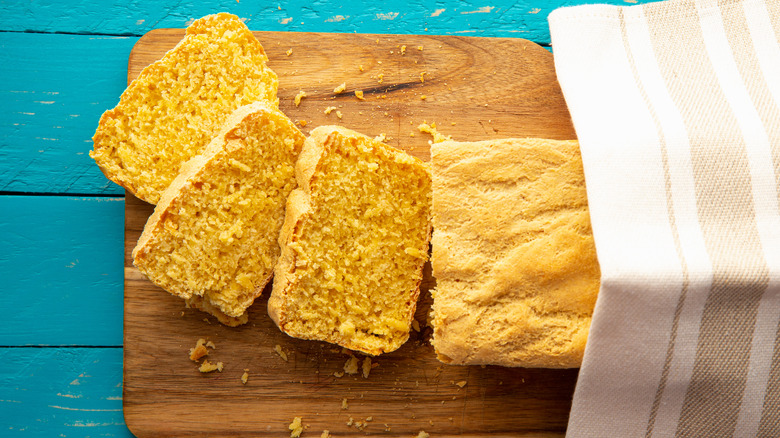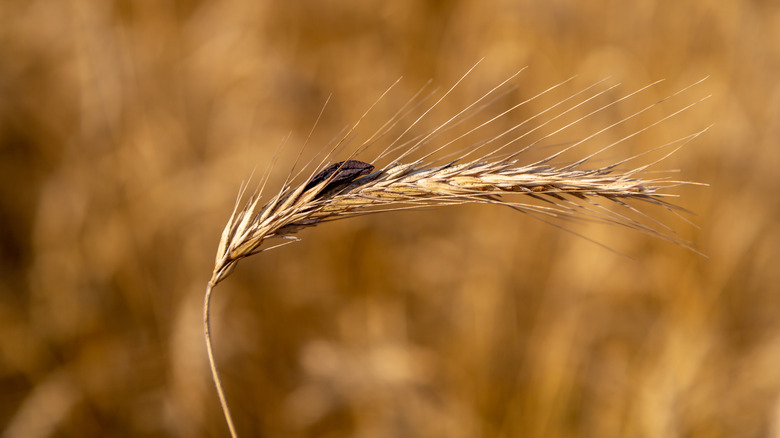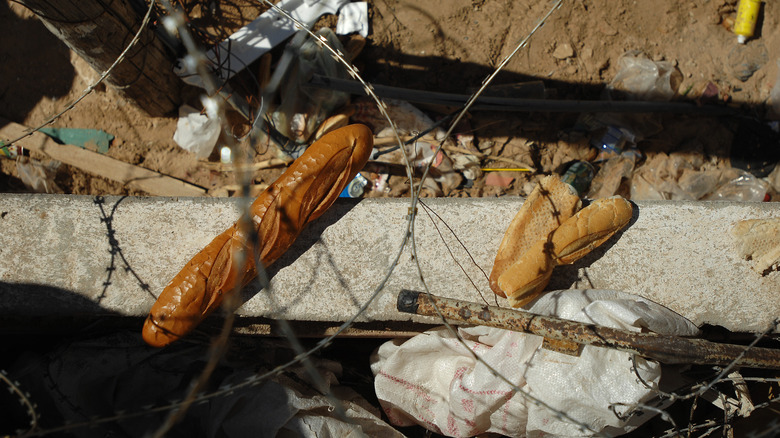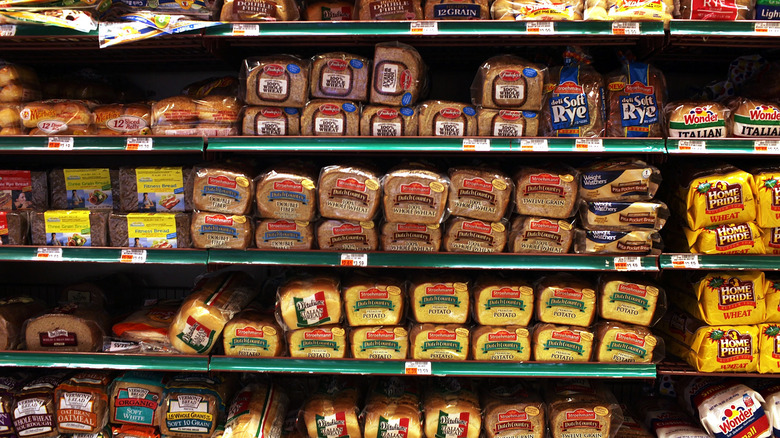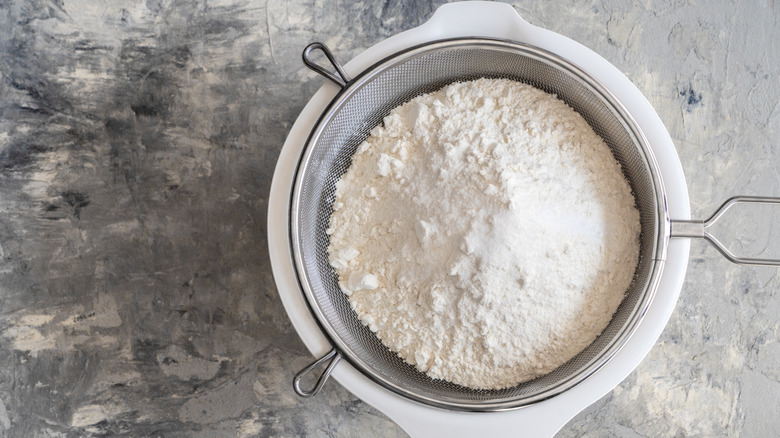The Long History Of Bread Explained
The history of humanity and civilization began long before the spread of agriculture, but once bread came into the picture, it became difficult to describe people without it. Whether as a food item or a symbol of justice, bread finds itself deeply intertwined with global human history.
Bread has found itself historically on opposite sides of the same coin, whether as a vector or treatment of a disease, or as a widely accessible or inaccessible commodity. This is because despite being just another food item, bread can also be a reflection of societal values. In "Our Daily Bread," Yugoslavian scholar Predrag Matvejević has even examined "the way the bread we eat becomes a vehicle for human relations," writes LARB.
Considering the numerous iterations of bread, it's unlikely that bread will ever disappear from the human menu. But in thinking about bread, it's worth looking back to where it came from and how it got here. This is the long history of bread explained.
What is bread?
Bread is defined to be a type of food made by mixing flour and water, and sometimes yeast or baking soda (or baking powder), and then baking, frying, or steaming the dough or batter. Bread can also vary greatly depending on the type of flour that is used, which can be made out of a variety of grains, including wheat, corn, sorghum, rice, barley, spelt, and teff, as well as seeds. As a result, bread can come in thousands of forms, ranging "from Chinese baozi to Armenian lavash," writes the Exploratorium.
Yeast and baking soda or powder are both known as leaveners, and while they are both used to create carbon dioxide in the batter, they work a little bit differently to produce the final bread product. While baking powder and baking soda work through chemical reactions to create carbon dioxide, according to Fine Cooking, yeast creates a liquid that releases carbon dioxide as it feeds on the simple sugars in flour. These two different carbon-dioxide-creating processes result in bread with very different textures, ranging from cornbread to sourdough bread.
The invention of bread came out of human experimentation with various grains and can be traced back to some of the earliest cultivators in Mesopotamia, Mesoamerica, sub-Saharan Africa, and East Asia, per The First Farmers. Up until 1,200 A.D., the English word for bread was "hlaf." But as the vocabulary became Frenchified, the word "hlaf" was replaced with "bread," which meant "morsel" or "piece," writes Bon Appetit.
The most common bread
Flatbread may be one of the most common breads in the world, and although its roots go back thousands of years, surviving examples from across the world like injera, lavash, pita, roti, kesra, tortillas, chapati, and piki are believed to resemble their early ancestors.
According to The Food Timeline, flatbreads may be considered to be the oldest bread of all. And although archeologists aren't sure how people initially baked the flatbreads, it's possible that it was done by putting the batter on a hot rock. In "A History of Cooks and Cooking," Michael Symons writes that some of the earliest clay ovens were found in present-day Iraq and date back to 5,000 B.C. Bread is cooked in these clay ovens by sticking it to the inside wall while a fire burns at the bottom of the cylinder, which allows both sides of the bread to cook simultaneously.
Also known as tandoors or tannurs, variations of these cylindrical clay ovens are still used today across the Asian and African continents. In the Sahara, a similar principle is used to cook Taguella, the bread of the Tuareg people, but without the clay-oven part. "Hot coals are placed into a hole that has been dug into the desert sand. The bakers place flattened pieces of bread dough onto the coals and then cover it with more coals and sand. When the breads are baked ... the sand is pushed aside and the breads lifted out."
The earliest signs of bread
Despite the fact that bread can be found on almost every single continent, the early history of bread remains largely a mystery. Some of the earliest signs of bread date back more than 10,000 years. PNAS writes that remnants of some of the earliest bread-like products were found in 2018 in northeastern Jordan, dating back almost 14,400 years. This is almost 4,000 years before what's considered to be the emergence of Neolithic agriculture. This find also predated what was previously considered to be the oldest evidence of bread, which was found in Turkey and dates back 9,000 years, BBC reports.
But people during the Paleothic period were making flour up to 32,000 years ago, NPR writes, so it's possible that individual groups of people were making their own versions of bread as early as the Paleolithic. However, it's ultimately unclear exactly when humans started considering bread to be a popular staple.
And although we know that bread would become a staple for numerous ancient cultures like the Uruk, Harappans, and Egyptian civilizations, as William Rubel notes in "Bread: A Global History," "We do not know who made the first breads."
Bread as currency
In Ancient Egypt, bread was so important that the Egyptian economy literally couldn't run without it because bread was one of the main forms of currency in the barter system. According to "The Ancient Egyptian Economy" by Brian Muhs, in addition to bread, other perishables like grain and fish were also exchanged in markets. Payments for services were also given in the form of "bread and beer, meat and fowl, and emmer wheat and barley," Marc Van De Mieroop writes in "A History of Ancient Egypt." The use of silver and bronze money in the Ancient Egyptian economy didn't become common until the "late first millennium BCE."
According to Rawi Magazine, "archeological remains related to bread baking [in Ancient Egypt] are abundant." In addition to wall depictions and inscriptions, ovens and mortars and grindstones have been frequently found by archeologists. Bread loaves can also be found in Ancient Egyptian tombs and burials, stemming from a belief that "ancestors get hungry" and also need to eat, an idea that gained traction around 3500 BCE, David Graeber and David Wengrow note in "The Dawn of Everything."
Beer is liquid bread
The Ancient Egyptians are also believed to have been some of the first to start using yeast as a leavener in bread-making during the New Kingdom. According to The Book of Fermentology, some of the earliest evidence of the use of yeast in bread in Ancient Egypt comes from 1300 to 1500 B.C. It's also believed that beer and bread shared a production connection as well, "as the yeast-filled dregs from brewers were given to bakers as an alternative to wild-caught sourdoughs," essentially making bread from the remnants of beer.
There's also evidence to suggest that yeast-risen bread was also being produced in Mesopotamia around the same time, if not earlier. "Beer is liquid bread," writes LiveScience, since it basically uses the same ingredients, so it's believed that the use of yeast in bread has "boozy roots."
The reverse also appears to have happened. JSTOR Daily writes that breweries in Egypt as well as Mesopotamia would also make beer by putting bread and yeast into jars of water.
Milling refinements
Initially, people were using variations of a mortar and pestle to grind their grains into flour for bread. But according to "On Food and Cooking" by Harold McGee, a mortar and pestle progressed to two flat stones, and by 800 B.C., continuous milling was invented. This would allow for "the grinding of grains into very fine flours with little human labor." In "The History of Bread," John Ashton notes that variations of these mills for grinding flour can be found across the Asian continent.
The Mills Archive writes that in the first millennium B.C., various types of continuous mills were invented and used to grind grains into a fine flour. By the 4th century B.C., animals were being used to power millstone in Greece and Italy. There are numerous types of these mills, but one of the earliest is the Pompeiian mill. This was typically powered animals, but sometimes enslaved people were also forced to power the mills.
Roman bakers guilds
Up until the year 172 B.C., there wasn't a specialized class of bakers in Ancient Rome. According to "Six Thousand Years of Bread" by Heinrich Eduard Jacob, bread was prepared by individual Roman women within the household. But in 168 B.C., the first Bakers Guild was formed by Roman men, and "within 150 years there were more than 300 specialist pastry chefs in Rome."
Bread was considered such an essential food item that almost everyone had access to it. Even those living in financial insecurity were given free bread. But in "Fermented Foods," Christine Baumgarthuber notes that while "the Egyptians understood the importance of bread; the Romans came to understand the importance of the baker." The bakers guild, known as Collegium Pistorum, was not only able to provide "solidarity and mutual aid," but bakers even had a representative in the Senate. Even the second mayor of Pompeii, Paquius Proculus, belonged to the bakers' guild.
However, not all bakers could hope to hold elective office, because some bakers were formerly enslaved people and "because of their status as former slaves, they could not hold elective office," according to The Art Bulletin.
But the tomb of Marcus Vergilius Eurysaces the baker is demonstrative of the high status that bakers could achieve. Considered to be "one of the largest and best-preserved examples of a freedman's funerary monument" and depicting details of his profession, Eurysaces is believed to have been rather wealthy to have been able to afford such a tomb.
Medieval bread
By the Middle Ages in Europe, loaf-breads became more popular than the flatbreads preferred in most of Africa and Asia. And according to the Penn State University Center for Medieval Studies, medieval physicians even recommended white bread as being healthier, as it "had special curative properties, when, in fact, it actually had less nutritive value than the breads which left in more of the wholesome wheat bran." This pure white leavened bread was sometimes even called "cake."
But white bread like this was a great luxury at the time, so few people would've been able to afford it. Most people instead baked "darker breads with oats or rye." which is what led to peasants being associated with black bread. However, despite the differing types of bread, everyone had "about a two-pound loaf of bread per day."
The Medievalists writes that in most of medieval Europe, there were also regulations "about how to make and sell bread," often to make sure that everyone had access to bread. Comparatively, in places like medieval Baghdad, most people would bake their own bread, with one market inspector reportedly stating that "most people avoid eating bread baked in the market" (via "Consider the Fork").
Indigenous cornbread
On the North American continent, corn has an incredibly long history, and for many Haudenosaunee people, including the Mohawk and Oneida, cornbread is a staple of cultural significance. According to the Oneida Indian Nation, the Oneida people used white corn for their corn flour and would cook the cornbread by boiling it. And in Érudit, Gerald Taiaiake Alfred writes that cornbread, also known as Kana'tarokhón:we, "is still our traditional staple and main connection to our ancestral food ways."
Cornbread is used in traditional Iroquois weddings, and although the practices have changed over time, "cornbread is still at its heart as the original food and as the symbol of the unification of families."
Indian Country Today writes that initially, European settlers "considered maize inferior to wheat" because the lack of gluten in maize means that bread doesn't rise the same way. But eventually, Indigenous recipes were adapted by European settlers, and in the case of cornbread, that gave rise to johnnycakes, or cornbread patties.
Ergotism
Although bread is often thought of as a positive thing, there have been times in history where bread has accidentally done more harm than good, thanks to the Claviceps purpurea fungus, also known as ergot. Throughout medieval Europe, there were occasional stories of "mysterious outbreaks that left thousands of people dead or permanently disabled," writes the American Society for Microbiology. Symptoms would range from gangrene in the hands and feet to convulsions and hallucinations.
But it wasn't until the late 1600s that the disease ergotism and its cause were identified. Egotism is caused by eating rye bread that was made from grains infected by ergot, and according to Medievalists, it's believed that in 994, up to 40,000 people were killed by ergotism in northern Germany alone. The disease was also known as St. Anthony's Fire, due to a group of monks who, having declared St. Anthony as their patron saint, attempted to assist during outbreaks in the 11th century.
Although ergotism has faded away in recent centuries, it's still known to occur, and there are some unexplained modern-day incidents that some have tried to attribute to ergotism. After a town in France was poisoned by bread in 1951, many continue to debate whether or not ergotism was responsible.
From bread to justice
As an important food staple, bread has been an important symbol of justice throughout history. There have been numerous bread revolts in Africa, Europe, and the United States, all of which can be considered to have greatly affected the course of human history.
According to "The Flour War," before the French Revolution, there were 652 food revolts between 1760 and 1789, and many of these were part of the Flour War, which were revolts specifically in response to the rising prices of grain and flour. And although the French Revolution had a variety of causes, the expensive cost of bread added a great deal of fuel to the fire of revolution. The Russian Revolution also had a similar catalyst. The Guardian writes that in the Russian Empire in March 1917, it was a women's strike on International Women's Day in response to the shortages of bread that brought on the subsequent revolution and overthrow of the Russian tsar.
In the 21st century, the importance of bread never waned. The Arab Spring, which lasted from 2008 to 2011, was also instigated by the spike in grain prices and led to a rise in bread price. In Egypt, the price of bread rose by 37%. And during the protests, images of bread were central.
Industrialized bread
By the 20th century, bread baking was industrialized by Europe and the United States. NPR writes that in the United States, Wonder Bread and Tip Top were some of the first to bring "factory automation to bread-making" in the 1920s, causing white bread to become "a symbol of industrialization and modernity." Sliced bread was also invented in 1928 and can be seen as "the culmination of a long process in which bread was engineered and designed to look like a streamlined wonder, like an edible piece of modern art."
Meanwhile, the industrialization of bread-making in England was underlined by the Chorleywood method. According to "Bread Therapy," the Chorleywood method could produce bread "quickly, cheaply, and in stupendous quantities," and by 2011, the Chorleywood method was responsible for 80% of the bread produced in the United Kingdom. However, the Chorleywood process involves using flour that had little nutritional value, and the choice of additives simply "speeds up the breadmaking process and increas[ed] the shelf life of the bread."
Enriched white bread
During the first half of the 20th century, as industrialized bread-making was taking off in the United States, a disease known as pellagra was also making the rounds. Caused by a lack of vitamin B3, also known as niacin, pellagra's connection to diet wasn't "proven and accepted until the 1930s," writes Chicago Magazine.
Pellagra is believed to be responsible for killing up to 150,000 Americans during the first half of the 1900s, and in response to the epidemic, the FDA and the American milling and baking organizations met to determine a course of action. After it was determined that the "super-milling" that creates white bread also removes a majority of the vitamins from bread, the bread industry decided to put those vitamins back into white bread.
Known as enriched or "supercharged flour," the enriched bread actually did wonders against preventing pellagra. According to "Critical Food Issues of the Eighties," bakers began to enrich bread in 1938, and by 1943, up to 80% "of all family flour and baker's white bread was enriched." And by that time, the number of people who died from pellagra had dropped to 2,000 and continued to drop over the following decades. Today, many commercially sold white bread continues to be enriched.
